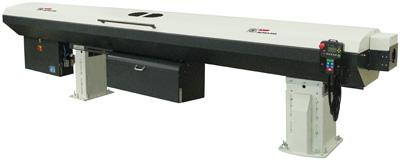
Two new additions to the LNS America Alpha line of lower-cost bar feeders provide consistent bar support and smooth, reliable bar loading for enhanced precision machining performance.
Alpha 538 is for sliding headstock machines and loads bar stock diameters from 0.20" to 1.5" (5mm to 38mm). Alpha 552 (pictured) is for fixed headstock machines and bar stock diameters from 0.20" to 1.85" and up to a maximum 2.047" in diameter with bar preparation (5mm to 52mm).
Both bar feeders use hydrodynamic or hydrostatic oil to safely support bar stock and reduce vibration transference. Exclusive LNS Quick-Change round guiding elements and pusher enable partial changeovers in less than 3 minutes and complete changeovers in less than 8 minutes.
For bar loading on sliding headstock machines, Alpha 538 includes a Swiss safety connection featuring a telescopic tube and T-Tube liners; the LNS patented 3-S direct electronic headstock synchronization system; a long pusher extension, depending on the machine configuration.
Other features standard on both bar feeders include: a high-capacity (11.8" wide) self-contained magazine tray for unattended and lights-out operation; easily accessible, centralized bar selection fingers adjustment; 2-position hydrostatic outboard stabilizer with Quick-Change bushing system; automatic torque and speed adjustment; heavy-duty, self-centering remnant retraction system with torque power booster that ensures reliable, consistent bar extraction and insertion; an 18.5" Z-axis retraction system for easier spindle liner changeovers and routine machine maintenance.
Contact Details
Related Glossary Terms
- bushing
bushing
Cylindrical sleeve, typically made from high-grade tool steel, inserted into a jig fixture to guide cutting tools. There are three main types: renewable, used in liners that in turn are installed in the jig; press-fit, installed directly in the jig for short production runs; and liner (or master), installed permanently in a jig to receive renewable bushing.
- precision machining ( precision measurement)
precision machining ( precision measurement)
Machining and measuring to exacting standards. Four basic considerations are: dimensions, or geometrical characteristics such as lengths, angles and diameters of which the sizes are numerically specified; limits, or the maximum and minimum sizes permissible for a specified dimension; tolerances, or the total permissible variations in size; and allowances, or the prescribed differences in dimensions between mating parts.
